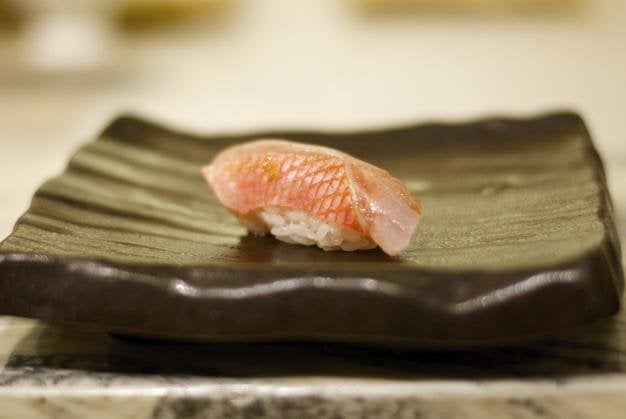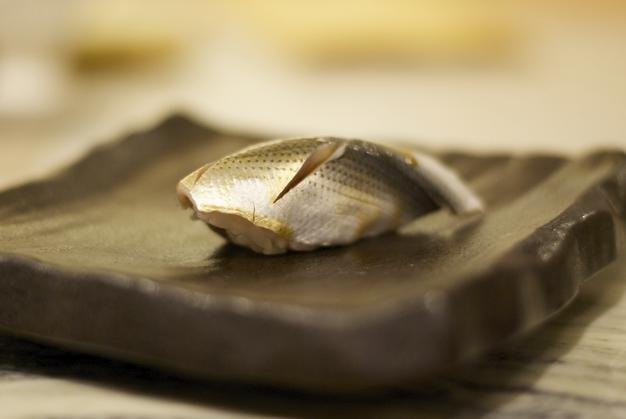
SHOUSHIN 3328 Yonge, 416-488-9400, shoushin.ca. See listing.
Shoushin is designed so that every line flows in the direction of the sushi bar, a long, pale counter that runs along the back half of the dining room. It’s made entirely from massive slabs of rare hinoki wood, sanded smooth so it’s satiny and buttery to the touch but left untreated and unvarnished. Water spots from glasses soak right in. To “clean” it, the staff has to sand it down completely every couple of days.
The designers liken it to a stage, and there is something balletic about Shoushin chef Jackie Lin‘s practised nigiri-forming motions: he presses the rice like he’s gently stretching out his hands. But hinoki wood, the staff tell me, is generally reserved for temples, which may be a more apt comparison: Lin’s dinners are precisely meted out, informative and illuminating, like a religious service.
Lin, formerly of Zen, created Shoushin to present high-end sushi as it’s done in Tokyo.
“They don’t just serve the fish as it is,” he says. “Usually, they do something about it. White fish they might marinate in kelp. Shiny fish like mackerel or sardine or shad they usually salt and then marinate in vinegar. Tuna they’d probably marinate in soy sauce.”

Chef Jackie Lin (right).
These traditions are rooted, he notes, in the need to preserve fish in times of unreliable refrigeration, so he takes (very occasional and very carefully considered) modern liberties.
Omakase tasting menus are available at three levels: $80, $120 (which includes an additional sashimi course) and $250 (which includes toro and sturgeon caviar and a serving of wagyu beef). At the core of each is a series of nigiri, formed piece by piece by Lin, who places each one as it’s done upon a dish in front of the diner. These are to be eaten with your fingertips, popped whole into your mouth less than 10 seconds after they leave Lin’s hands.
Meals begin with two starters. On my visit, they were a trio of single bites that included a melt-in-your-mouth slice of black cod, followed by a little bowl of chawanmushi (savoury custard) layered with a spinach purée and chunks of finely chopped shrimp that I could have sworn was just a flaky fillet of some other tasty creature.

And then the parade of a dozen or so nigiri began, with Lin announcing each piece. Mild fluke topped with a little lemon zest. Surprisingly silky, if chewy, Japanese squid. Lean, then medium, then fatty tuna, in sequence so the qualities of each reveal themselves more fully. Kingfish that’s been smoked (a Lin signature) to lend gentle warmth. A slice of octopus that made me realize my long-time dislike of octopus sushi was entirely the fault of the octopus I was eating. Silver-skinned shad, marinated in vinegar, that tastes like the sea.
Lin is picky – almost dogmatic – about what he serves. About 70 per cent of the restaurant’s fish is wild-caught, imported from Japan.
“You don’t have to think, ‘Is it harmful? Is there anything they eat that’s not good for you?’ No, people have been eating it for thousands of years.”
He’s also adamant that the biodiversity of the oceans around Japan leads to finer fish overall.
A very, very select few farm-raised specimens might end up in front of you at Shoushin – whatever passes the chef’s muster. And no raw salmon, ever: “It’s not as good as everyone would think, actually,” he says with a laugh.
“It’s a cultural thing, too. In Tokyo, they never eat it raw.”
Want more of Toronto’s best Japanese? Click here.
nataliam@nowtoronto.com | @nataliamanzocco












